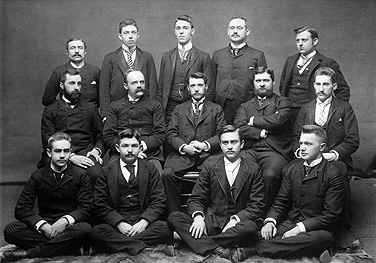Flashback
125 years ago
UB’s second professional school

Buffalo College of Pharmacy graduating class, 1890. Photo: UB ARCHIVES
The School of Pharmacy and Pharmaceutical Sciences—UB’s second professional school—celebrates its 125th anniversary this year. Instruction began on Sept. 20, 1886, with 38 beginning students.
The Buffalo College of Pharmacy—the school’s original name—was established in response to a growing demand for systematic instruction in pharmacy. At its third annual meeting, held in Buffalo in 1881, the New York Pharmaceutical Association urged the establishment of college of pharmacy in Western New York.
After the Erie County Board of Pharmacy announced in 1884 new conditions for obtaining a pharmaceutical license—passing an exam or obtaining a diploma—there were renewed calls for a pharmacy school to be established.
The following account of the founding of the school was written by Robert Devens and appeared in the winter 1996 issue of UB Today:
“Frank Vandenbergh, professor of chemistry in the UB medical department, declared, “Surely in requiring an examination, these laws call loudly for systematic instruction; but in addition, there is an expressed demand (for it) on the part of local druggists.
“Given new laws and increasing demand for systematic pharmacy training, Vandenbergh was invited to research the issue and report his findings to the UB Council. With a businessman’s eye for a potential market, he located what he called a ‘great circle of territory’ unoccupied by a college of pharmacy: Western New York, Western Pennsylvania, and portions of Ohio and southern Ontario.
“In 1886, Vandenbergh made a persuasive presentation before the council, urging the establishment of a department of pharmacy in the University of Buffalo. During the following month, ‘with little debate or discussion,’ the council authorized the creation of the Buffalo College of Pharmacy, the first new academic unit since the university’s founding 40 years earlier.
“The pharmacy college was funded by the combination of subscriptions—which yielded $750—and student fees. Incoming students were charged $50 for a 20-week academic year, or $100 for what was termed a ‘perpetual ticket.’ This ticket allowed a student to take as many courses as he or she liked. Perhaps not surprisingly, this promise of perpetuity did not last beyond the department’s early years.
“Although the college would be run by faculty, it would work with a board of ‘seven reputable pharmacists,’ preserving those dialogues between academics and professionals so instrumental in the school's founding.”
The University Archives holds extensive collections of administrative records for Pharmacy’s first 125 years in addition to the papers of Dean A B. Lemon, 1924-1969 and records of the Pharmacy Alumni Association, 1889-1976.
—John Edens, University Archives

Reader Comments